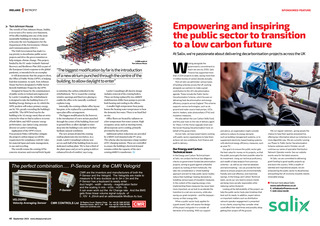




IRELAND | RETROFIT Tom Johnson House The retrofit of Tom Johnson House, Dublin, is set to turn a five-storey over-basement, 1970s office building into one of the most sustainable buildings in Ireland, ready to become the new headquarters for the Department of the Environment, Climate and Communications (DECC). The Irish Government has made it a top priority to decarbonise public sector projects and drive the green transition to help mitigate climate change. This project, funded by the EU under Irelands National Recovery and Resilience Plan 2021 as part of the European Unions response to the global pandemic, is intended to be an exemplar. It will demonstrate that the projects client, the Office of Public Works (OPW), is helping lead that transition. As such, Tom Johnson House has been designated a Public Sector Retrofit Pathfinder Project by the OPW. Designed in-house by the commissioners of public works in Ireland and engineered by Lawler Consulting, the refurbishment is designed to take the building from a C3 Building Energy Rating to an A2, which the OPW predicts will reduce primary energy use by 75%, greatly extending the buildings useful life. The OPW brief was for the building to be A2 energy rated; that set strict criteria for what we had to achieve in terms of both fabric and MEP systems energy performance, says James Long, associate director at Lawler Consulting. Application of the OPWs Green Procurement Policy will further mitigate the projects carbon impact as will the requirement for compliance with EU rules for material input and waste management, re-use and recycling. The retrofit retains the existing 1970s concrete structure and external brick faade 40 September 2023 www.cibsejournal.com A BIM model of Tom Johnson House The biggest modification by far is the introduction of a new atrium punched through the centre of the building, to allow daylight to enter to minimise the carbon embodied in the refurbishment. Weve reused the existing window openings and fitted new glazing to enable the office to be naturally ventilated, explains Long. Internally, the existing cellular office layout has gone, to be replaced by a predominantly open plan office arrangement. The biggest modification by far, however, is the introduction of a new atrium punched through the centre of the building, from roof to ground floor, to allow daylight to enter deep into the buildings core and to further facilitate natural ventilation. The new atrium divided the existing rooftop plantroom into two halves. As a result, Lawler Consultings scheme now serves each half of the building from its own dedicated rooftop plant. Weve lost a third of the plant space and yet were going to deliver enhanced levels of comfort, says Long. Lawler Consultings all-electric design includes removal of the existing boilers. These are being replaced by two, 600kW multifunction chiller heat pumps to provide both heating and cooling to the offices. A smaller high-temperature heat pump boosts the heating water temperature to heat the domestic hot water. There is no fossil fuel on site. Office floors are heated by radiators on a low-temperature hot-water system. High occupancy areas, such as meeting rooms, all incorporate active cooling, primarily provided by fan coil units. Additional carbon reductions are provided by a 50kW roof-mounted solar PV array. The scheme also incorporates a large number of EV charging stations. These are controlled to ensure the buildings electrical demand remains within the capacity of the sites existing 600kVA transformer. CJ